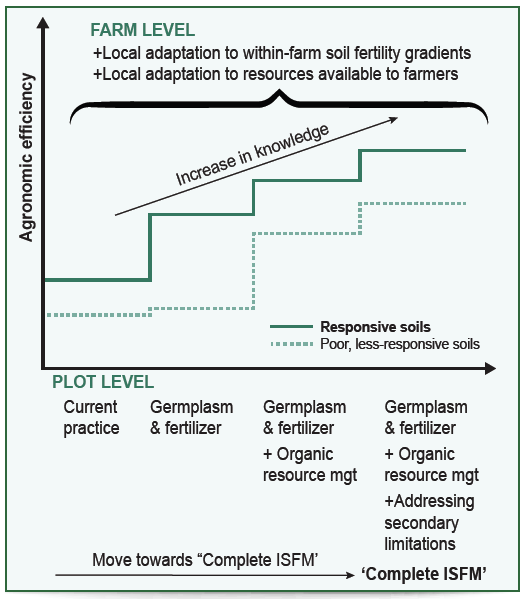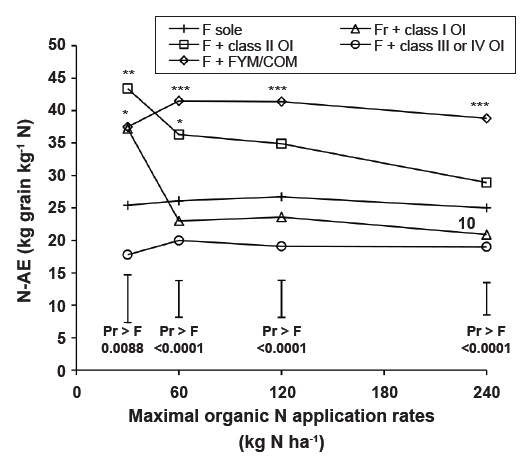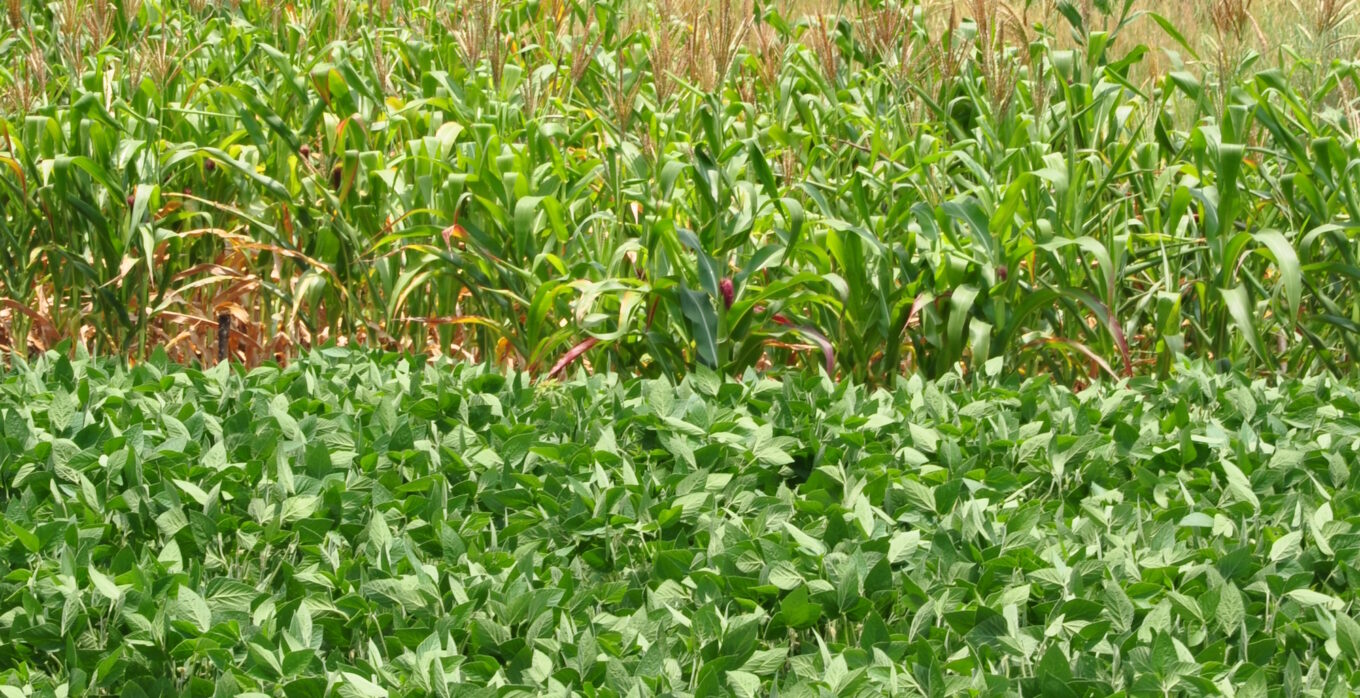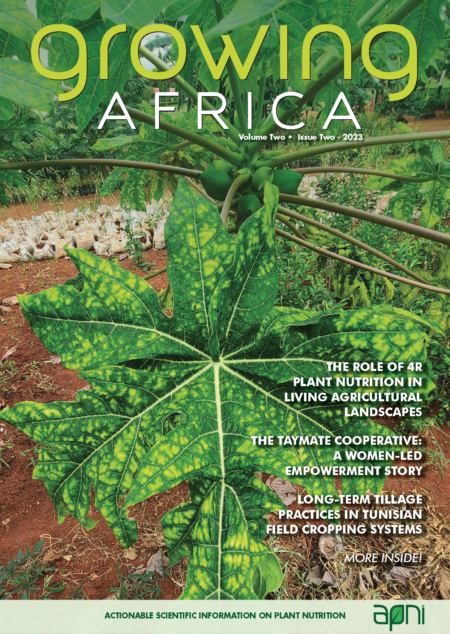By Bernard Vanlauwe
There remains a critical need in Africa to implement strategies to brace the continent against its triple threat of degrading soils, increased climatic vulnerability, and a surging need for nutritious foods. Through years of adaptive research, Integrated Soil Fertility Management (ISFM) has evolved into a balanced and inclusive agronomic concept well positioned to tackle these challenges. Still, effective implementation at scale is only achievable given innovative, locally adaptable dissemination technologies, and robust agriculture industry and financial support.
Conceptualization of ISFM
The Integrated Soil Fertility Management (ISFM) approach is a logical consequence of earlier failed attempts to increase crops yields in sub-Saharan Africa (SSA), first through Green Revolution-type approaches driven by improved varieties and fertilizers in the 1960s and 70s, followed by attempts to avoid fertilizer altogether in the 1980s and 1990s by seeking biological means for yield improvement (Vanlauwe et al., 2017).
In 1994, the Second Paradigm for Tropical Soil Fertility Management, launched by Sanchez (1994), was phrased as ‘the need to rely more on biological processes to optimize nutrient cycling, minimize external inputs and maximize the efficiency of their use’, and thus accepted that both fertilizer and organic inputs are required to boost crop productivity in SSA. While the Second Paradigm triggered substantial efforts to generate organic resources in-situ, thereby recognizing that some fertilizer would be needed, ISFM is built on similar principles but focuses on the use of fertilizer as an entry point toward the intensification of smallholder agriculture.
The Fertilizer Summit, held in Abuja, Nigeria, in 2006, emphasized the need for increased use of fertilizer in Africa from the then 8 to 50 kg fertilizer nutrients ha-1 to increase crop production and reduce the importation of food from outside the continent. Soon after in 2009, in the context of the formulation of a soil strategy for the Alliance for the Green Revolution in Africa (AGRA), ISFM was re-conceptualized with a focus on maximizing the use efficiency of fertilizer. This focus was justified by the high costs of fertilizer and the need to avoid losses of nutrients to the environment – a criticism often associated with Green Revolution approaches. Agronomic efficiency (AE) is defined as incremental return to applied inputs or:
AE = (YF – YC)/(Fappl)
where YF and YC refer to crop yields (kg ha-1) in the treatment with and without nutrients, respectively, and Fappl is the amount of fertilizer nutrients applied (kg ha-1). With constant fertilizer application rates, increased AE results in increased crop productivity.
Key principles
ISFM was thus defined as ‘a set of soil fertility management practices that necessarily include the use of fertilizer, organic inputs, and improved germplasm combined with the knowledge on how to adapt these practices to local conditions, aiming at maximizing agronomic use efficiency of the applied nutrients and improving crop productivity. All inputs need to be managed following sound agronomic principles.’ This definition entails two key dimensions: (i) a set of generally applicable principles and (ii) the need for local adaptation.
The key principles underlying ISFM were formulated based on many decades of agronomic research in SSA and supported by a vast amount of scientific evidence. First, fertilizer needs to be used properly for it to generate best responses. The 4R Nutrient Stewardship (IPNI, 2016), a science-based framework developed by the global fertilizer industry, focuses on applying the right fertilizer source at the right rate, at the right time in the growing season, and in the right place in the soil and provides an essential basis for optimizing the use of nutrients. Secondly, improved crop varieties are required to maximize the agronomic benefits from the supply of nutrients. Such germplasm could be resistant to key pests or diseases, tolerate abiotic stresses such as drought, or contain hybrid vigor. Thirdly, fertilizer combined with organic inputs is advocated as a sound management principle for smallholder farming in the tropics because (i) neither of the two inputs are usually available in sufficient quantities, (ii) co-application can result in added benefits that each input by itself cannot generate, and (iii) both inputs are needed in the long-term to sustain soil fertility and crop production since organic inputs also supply C to the soil, thus contributing to the build-up of soil health. It is important to note that organic inputs refer to all available resources, either produced in-situ (e.g., crop residues) or transferred from elsewhere within or outside the farm (e.g., farmyard manure). Fourthly, good agronomic practices refer to crop and soil management practices that allow crops to grow and yield optimally, including appropriate land preparation, planting times, plant populations, intercrops, weed and pest and disease management, and harvest procedures. Many studies have confirmed that sub-optimal agronomic practices are main contributors to the current yield gaps in SSA (Pradhan et al., 2015; ten Berge et al., 2019). Lastly, local adaptation refers to the need to address locally relevant constraints to crop growth (i.e., the application of lime in areas with soil acidity-related constraints).
ISFM is a stepwise approach that begins with rehabilitating degraded soils and improving marginal soils, first by using mineral fertilizers and improved germplasm (Fig. 1). Due to the widespread extent of low soil nutrient availability and a paucity of organic resources, fertilizers are considered a necessity to begin rebuilding the fertility base of the vast majority of soils. The next step is incorporating organic resources into soil management, which is necessary to rebuild the soil organic matter key to soil health and integral to multiple soil functions. This second step, however, can only happen once there is sufficient biomass in the farming system. A final step refers to the need for additional amendments where fertilizer and organic inputs cannot address specific constraints such as those that are related to soil acidity, for example. The steps involved in ISFM vary with the local conditions and constraints to improving crop productivity and rehabilitating soils. The entry point for farmers to invest in ISFM depends on the initial soil conditions and the resources available.

The quality of the organic resources and the amount of N applied as fertilizer affect increases in AE values when combining fertilizer with organic inputs. Organic resource quality is related to the speed with which these decompose. High quality Class I residues (with N contents above 2.5%, lignin contents below 15%, and polyphenol contents below 4%) decompose relatively fast and their N availability behaves much like commercial fertilizer. As such, Vanlauwe et al. (2011) show that their impact on AE is mainly observed at very low levels of N application (Fig. 2). Intermediate quality organic inputs belonging to Class II (N > 2.5%; lignin < 15%, polyphenols > 4%) and manure/compost had significantly higher N-AE values than the sole fertilizer treatment or the Classes I and III (N > 2.5%; lignin < 15%, polyphenols > 4%), or low-quality Class IV organic inputs (Fig. 2). At higher organic N application rates, only the treatment with manure/compost gave significantly higher N-AE values than the sole fertilizer treatment (Fig. 2).

Heterogeneity and local adaptation
One element not yet covered concerns local adaptation to heterogeneity in smallholder farming systems. I grew up in a village in Belgium, surrounded by maize cultivation at particular times of the year. When I rode around those fields on my bicycle as a young boy, all the maize crops looked exactly the same in relation to height and color and they were anticipated to produce excellent yields – something I did not know yet at that time. The same can be said for other agricultural areas like the Cerrado of Brazil (Fig. 3a). However, the situation in areas of SSA, with relatively dense rural populations, is totally different with maize showing all possible heights and colors over very short distances, often within the same smallholder farm commonly less than 2 ha in size (Fig. 3b).

Within SSA farming communities, a wide diversity of farmer wealth classes and production objectives may be distinguished. In western Kenya, Tittonell et al. (2005a) identified that some small farms were owned by wealthy households that had external income from pensions or remittances and for whom farming is not their primary income. Such households are not expected to consider agricultural investments a priority. In contrast, well-resource endowed farmers with large areas of land make a relatively good living from farming. Poor households with very small farms have limited access to resources, often selling their labour to other households, In terms of climate change mitigation, besides potential increases on soil organic carbon stocks, improving the use efficiency of fertilizer can reduce the losses of fertilizer-derived greenhouse gasses, N2O being the most important one.
In relation to human nutrition, the nutritional quality of crops and production systems in the context of ISFM can be improved by (i) integration of legumes of which the residues can be used as a source of organic matter to be applied with fertilizer and/or (ii) application of fertilizer or organic inputs with a relatively high concentration of human nutrition-related micronutrients.
Scaling of ISFM
Application of ‘complete ISFM’, including the general principles and local adaptation requires substantial knowledge. The abundance of agricultural technology solutions and the huge investments in information and communication technology being made into the agriculture sector suggest that there is recognition that such knowledge will eventually be transmitted via more effective and low-cost digital channels. However, there is still a relatively high level of asymmetry between the availability of tools and their effective use.
Despite all the complexities, clear wins are being made, which bodes well for taking ISFM solutions to scale, as illustrated by the reach and use of the AKILIMO site-specific fertilizer recommendation portal (www.akilimo.org). By the end of 2022, the partnership had grown to 244 organizations, of which 128 organizations actively use AKILIMO in their operations. 10,156 dissemination events had been registered by a total of 120 partners who integrated AKILIMO in their scaling strategies. We had trained a total of 7,289 extension agents of which 38% were female. We reached a total of 447,818 farmers of which 39% were female, and of which 274,584 are registered AKILIMO users. In Nigeria, 92% of registrants continue to actively use the tools versus 78% in Tanzania. In all, 49% fully and 39% partially apply the recommendations in their farms in Nigeria versus 23% and 64% respectively in Tanzania. We estimate that, by the end of 2022, AKILIMO recommendations were applied on over 350,000 ha of land across both countries, with an average yield increase of 21% and over US$55 million additional crop value generated.
Lastly, ISFM will not scale unless the knowledge on how to implement ISFM is accompanied by access to agro-inputs, finances and insurance, produce quality implements, and output markets. After all, ISFM advocates investing in agronomy and soil fertility management and sustaining such investments requires sufficient returns on those. Reference to ‘bundled services’ is commonly made and ‘complete ISFM’ will most likely be adopted in situations where such bundled services are provided.
Dr. Vanlauwe (e-mail: B.Vanlauwe@cgiar.org) is R4D Director at the International Institute of Tropical Agriculture (IITA), Nairobi, Kenya.
Cite this article
Vanlauwe, B. 2023. Integrated Soil Fertility Management: Building on past experiences to address future challenges, Growing Africa 2(1), 23-27. https://doi.org/10.55693/ga21.GBGE3429
REFERENCES
IPNI. 2016. 4R Plant Nutrition Manual: A manual for improving the management of plant nutrition. International Plant Nutrition Institute.
Pradhan, P. et al. 2015. Closing yield gaps: How sustainable can we be? PLoS One 10, 1-18.
Sanchez, P.A. 1994. Tropical Soil Fertility Research: Towards the second paradigm. In Transactions of the 15th World Congress of Soil Science, Vol. 1, pp. 65-88. Acapulco, Mexico: International Soc. Soil Sci. and Mexican Soc. Soil Sci.
ten Berge, H.F.M., et al. 2019. Maize crop nutrient input requirements for food security in sub-Saharan Africa. Glob. Food Sec. 23, 9-21.
Tittonell, P., et al. 2005a. Exploring diversity in soil fertility management of smallholder farms in western Kenya. I. Heterogeneity at region and farm scale, Agric., Ecosys. and Environ. 110, 149-165.
Tittonell, P., et al. 2005b. Exploring diversity in soil fertility management of smallholder farms in western Kenya. II. Within farm variability in resource allocation, nutrient flows and soil fertility status, Agric., Ecosys. and Environ. 110, 166-184.
Vanlauwe, B., et al. 2010. Integrated Soil Fertility Management: Operational definition and consequences for implementation and dissemination. Outlook on Agric. 39, 17-24.
Vanlauwe, B., et al. 2011. Agronomic use efficiency of N fertilizer in maize-based systems in Sub-Saharan Africa within the context of Integrated Soil Fertility Management. Plant and Soil 339, 35-50.
Vanlauwe, B., et al. 2015. Integrated Soil Fertility Management in sub-Saharan Africa: Unravelling local adaptation. SOIL 1, 491-508.
Vanlauwe, B. et al. 2017. Looking Back and Moving Forward: 50 years of soil and soil fertility management research in sub-Saharan Africa; Int. J. Agric. Sustain. 15, 613-631.





